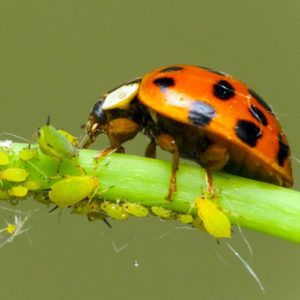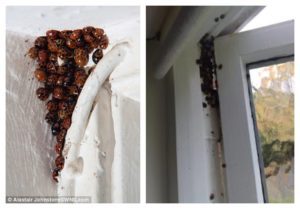By Sharon Harris, Harris Garden Cards
In winter, we humans stay inside to keep warm until spring, and some unwanted guests move in and stay with us – the bugs!
Ladybird or lady beetles, AKA ladybugs, are frequent boarders in our homes during this time of year, huddling together (to stay warm) in ceiling corners, lighting fixtures, windows, and attics. I certainly don’t blame them, but I wish they’d find a sheltered place outside the house. Most bugs crowd into hidden spaces outside that you’d rarely notice, like cracks in house clapboards, around attic vents and plumbing pipes, inside toolsheds and walls, under tree bark, and in leaf piles.
(to stay warm) in ceiling corners, lighting fixtures, windows, and attics. I certainly don’t blame them, but I wish they’d find a sheltered place outside the house. Most bugs crowd into hidden spaces outside that you’d rarely notice, like cracks in house clapboards, around attic vents and plumbing pipes, inside toolsheds and walls, under tree bark, and in leaf piles.
I contacted pest control companies, and here’s a rundown on what they recommended:
- Why are ladybugs in my house?
They’re hibernating; their lifespan is 10 months – 2 years.
- How did they get into the house?
They squeezed in around attic and gable vents, windows, and doors, like wasps do during the summer.
- How can I get rid of them?
 In your home, use a shop-type vacuum to remove them. Try not to mash them because their yellow-orange blood will stain the ceiling, furniture, and walls. They secrete this liquid when they’re threatened as a stinky and distasteful repellent to their enemies. They are also known to pull in their legs and play dead. Outside, you can caulk cracks and holes on the exterior of the house to reroute, hopefully, the pests to trees and natural ground covers.
In your home, use a shop-type vacuum to remove them. Try not to mash them because their yellow-orange blood will stain the ceiling, furniture, and walls. They secrete this liquid when they’re threatened as a stinky and distasteful repellent to their enemies. They are also known to pull in their legs and play dead. Outside, you can caulk cracks and holes on the exterior of the house to reroute, hopefully, the pests to trees and natural ground covers.
- Is poison an answer?
In the home, spraying and leaving a residue only lasts for a short time. You wouldn’t want to get spray stains on ceilings and walls, but you could try spraying cracks around attic vents, windows, and doors. The effect won’t last long, though.
It’s important to remember that ladybugs are a very beneficial bug to have in our yards to eat other pests on our flowering shrubs and garden vegetables. Daily, they can consume 50-100 soft-bodied insects, like aphids and white flies. Spraying shrubs and other vegetation during the warm months with poisons kills all bugs, even the ones you’d like to keep. Check the label of pesticides to see whether they will affect all insects or only specific ones.
- Will they bite people?
Their presence is a nuisance, but it’s not in their nature to go after humans or pets to bite. Because they have mandibles (look like pinchers), they can bite when provoked. They have no venom, and it would feel like a tiny pinch or sting. The Asian lady beetle is aggressive and is more prone to bite. Its color and markings are slightly different from the other species, and you can view those differences in various online photos.
(look like pinchers), they can bite when provoked. They have no venom, and it would feel like a tiny pinch or sting. The Asian lady beetle is aggressive and is more prone to bite. Its color and markings are slightly different from the other species, and you can view those differences in various online photos.
- Are they toxic?
According to the experts at Terminix: Although they can bite, they prefer to release their yellowish blood with its foul odor to get you to release them. A person who is sensitive to bug bites could develop an infection or rash, and they should seek medical attention, if needed. Pets may get sick from licking the bug blood or eating ladybugs, but the odor may repel even the most curious dogs. For more info: www.terminix.com
- Do they chew on things inside my house, like termites do with wood?
No. The adult ladybugs in the house already gorged themselves on pollen, nectar, and water before their hibernation stage. They’re ready to relax and sleep.
- Is it possible that they will reproduce (Yikes!) in the warmth and comfort of my house?
An entomologist told me that the lady beetle’s lifecycle is already past the mating stage in winter. He said it’s a myth that they breed inside homes when it’s cold.
- Is there something I can do to keep them from coming inside my house next winter?
 Unfortunately, these adult ladybugs release pheromone to attract others during mating AND hibernation. They mark the warm, safe hideaway they found in order to guide offspring to the same shelter the next winter. Fill the cracks and spaces you believe they used to enter your home. Ladybugs don’t like citrus oil, citronella, cloves, or bay leaves. Applying this near entry points may deter them from taking that path in, but you’ll need to reapply as it wears off. You could also plant mums, which the bugs avoid due to their scent, near windows and doorways. You can contact a pest control service for more tips.
Unfortunately, these adult ladybugs release pheromone to attract others during mating AND hibernation. They mark the warm, safe hideaway they found in order to guide offspring to the same shelter the next winter. Fill the cracks and spaces you believe they used to enter your home. Ladybugs don’t like citrus oil, citronella, cloves, or bay leaves. Applying this near entry points may deter them from taking that path in, but you’ll need to reapply as it wears off. You could also plant mums, which the bugs avoid due to their scent, near windows and doorways. You can contact a pest control service for more tips.
Besides humans who don’t want them, ladybugs have others who make them vanish. During the warmer seasons, natural predators are birds, tree frogs, dragonflies, and some ants that prey on lady beetles and, in doing so, maintain a healthy eco-balance in our yards.
Sharon Harris is an amateur gardener and does not have all the answers. But she knows the professionals to ask who do.



5 Responses
Interesting info. I was never bitten by a lady bug until the last five years or so. Now, it seems that they all bite if one lands on me.
Debbiejo, I was bitten once but didn’t have any problems as a result. I learned that usually the only ones who bite are the Asian ones, and we have many of those in our region!
Thanks so much for sharing,
Sharon
Awesome web site and article.
Harriet, Thank you! I appreciate your review.
Sharon
I found this interesting and wanted to share it with you! The ‘lady’ part of their name is said to refer to the Virgin Mary. No, “lady” does not mean all of the bugs are female. Here’s the backstory, courtesy of the Lost Ladybug Project: “During the Middle Ages in Europe, swarms of aphids were destroying crops. The farmers prayed to the Virgin Mary for help — and help came in the form of ladybugs that devoured the plant‐destroying pests and saved the crops. The grateful farmers named these insects ‘Our Lady’s beetles,’ a name which had endured to present day.”